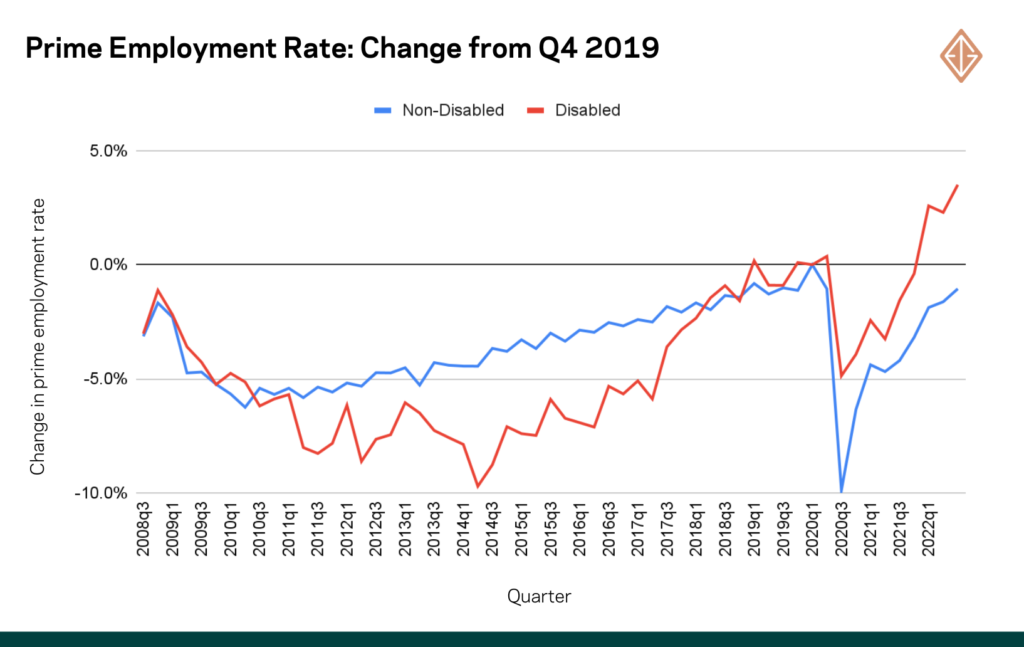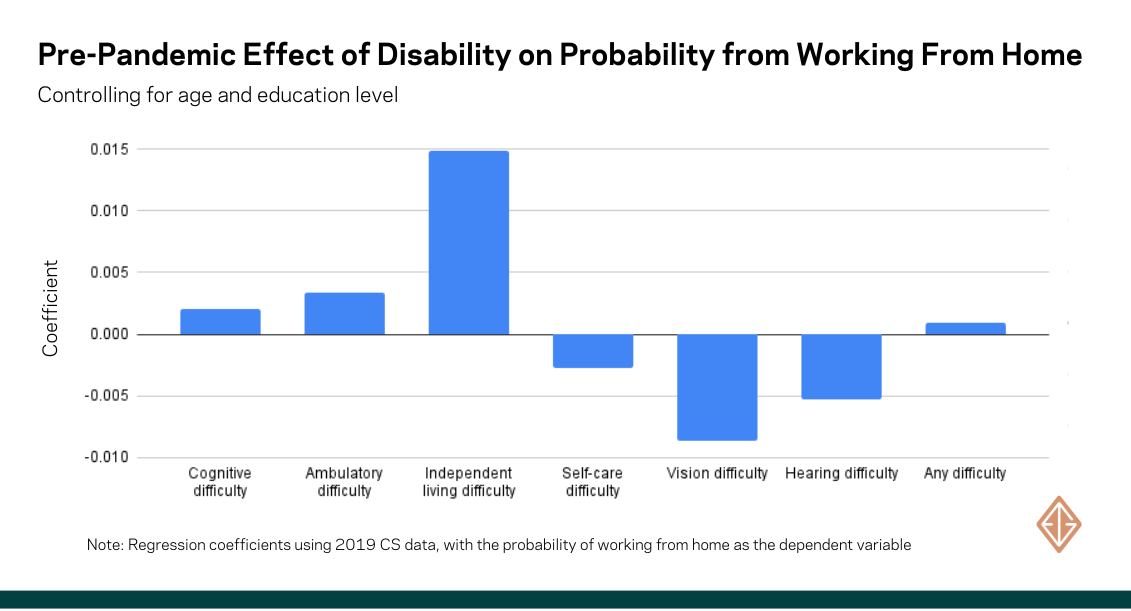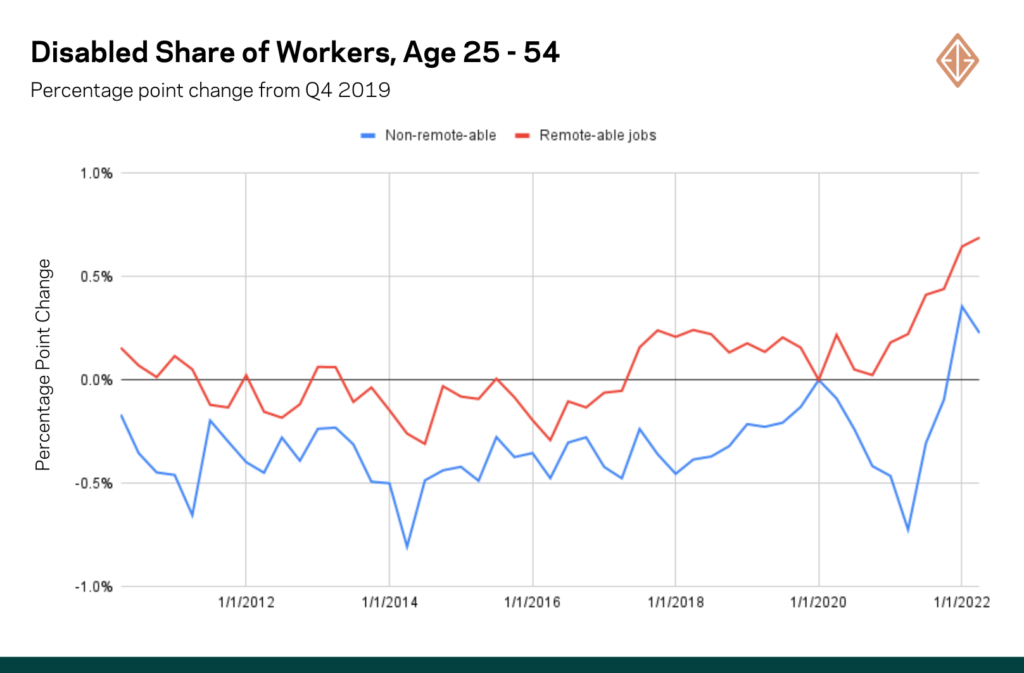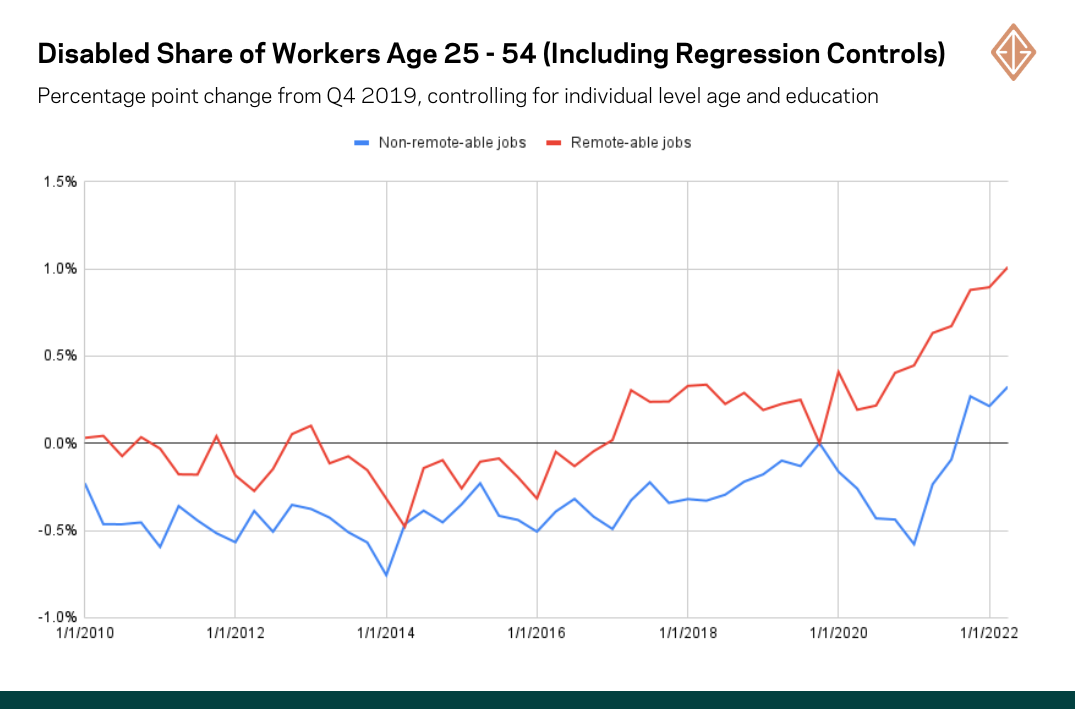by Adam Ozimek
The labor market, and the economy overall, are beset with a variety of problems. However, one pandemic silver lining has been under-discussed: the employment rate for people with disabilities has far surpassed its pre-pandemic level and is now the highest it has been since at least the Great Recession. In this analysis, Current Population Survey (CPS) data is used to show that strong labor market and remote work are two key factors that appear to be boosting the employment rate for Americans with disabilities. While the possibility of a recession clouds the near-term economic outlook, both factors bode well for the longer-term prospects for helping disabled individuals who want to find employment opportunities but face significant barriers navigating the job market.
Employment rates among people with disabilities climbed steadily pre-pandemic, then dropped along with the rest of the labor market, but have recovered quickly post-pandemic. People with disabilities in their prime working years, age 25 to 54, are 3.5 percentage points more likely to be employed in Q2 2022 than they were pre-pandemic. In contrast, non-disabled individuals were still 1.1 percentage points less likely to be employed. This welcome development represents a greater opportunity for individuals who typically have faced employment and retention barriers. Improving job access for people with disabilities remains an important and incomplete task. It is important to understand what is driving this trend to illuminate whether there is more policymakers can do to remove obstacles for workers with disabilities and whether the trends will be permanent.

Pre-pandemic, employment rates for people with disabilities were rising faster than for non-disabled people. This suggests that it is not simply pandemic-specific factors, but a continuation of pre-pandemic trends, that is helping. Specifically, the gradual tightening of labor markets before the pandemic created job opportunities for workers with disabilities. Research has shown that when labor markets are slack, with lots of available workers and few available jobs, employers raise the skill and experience requirements for jobs. These tougher hiring standards and more aggressive candidate screenings likely disproportionately harm people with disabilities, as employers with a larger pool of candidates may not provide the accommodations that workers with disabilities may require.
This positive trend in employment rate growth for people with disabilities has continued after the pandemic. With wage growth and job openings high, the data suggests that labor demand has outstripped labor supply for at least the last year, creating labor shortages. This appears to have been a boon to employment rates for the disabled.
However, tight labor markets are not the only factor, given the acceleration of disabled employment post-pandemic has been faster than that of non-disabled people. What might account for that take-off? The rapid growth of remote work has created more opportunities for all workers, but in particular people with disabilities. Pre-pandemic, workers with disabilities were overall more likely to work from home than non-disabled workers, according to 2019 ACS data. Among workers, 6.3 percent of disabled individuals worked at home compared to 5.9 percent of non-disabled individuals.
However, the correlation between remote work and disability was affected by two countervailing factors: older workers are more likely to be both disabled and work from home, and workers with higher education levels are more likely to work from home but less likely to be disabled. In addition, remote work is more helpful for some types of disabilities, like for those with mobility challenges, than others, like those who are visual or hearing impaired that benefit from assistive technologies. Using regression to control for age and education levels, those with cognitive difficulty, ambulatory difficulty, and independent living difficulty were significantly more likely to work from home in 2019.

In the aftermath of the pandemic, we can investigate whether remote work has affected disabled employment using CPS data. Starting in May 2020, the CPS asked whether an individual was working remotely because of COVID. However, these responses can be a problematic measure of remote work because they exclude pre-pandemic remote work and also those who, post-pandemic, are now permanently remote, thus only capturing a subset of those working remotely. [1] However, while an individual’s remote work status may be a problematic measure of whether they are actually remote, the data can be used to identify occupations that largely can’t be done remotely which should be a useful proxy for whether the ability to work remotely has benefitted disabled workers post-pandemic.
Specifically, we define as non-remote-able those occupations where the share of workers who were remote during 2021 was less than 3.1 percent, which represents one-third of all workers. The rest are in occupations we consider at least somewhat remote-able. Using this definition, we can classify anyone in any year as being in a remote-able or non-remote-able occupation. The data shows that the share of workers aged 25 to 54 who are disabled has increased the most in remote-able occupations, and is now 0.8 percentage points above pre-pandemic levels. [2]
In addition, in remote-able jobs, the disabled share of workers did not decline during the period of greatest job losses. This means that in remote-able jobs, while many people with disabilities lost jobs, they did not lose them disproportionately like they did in non-remote-able jobs. In other words, remote work may help put workers with disabilities on a more equal footing, and prevent last-in-first-out outcomes.

The same basic pattern holds if we first use regression analysis to control for age and education levels as well. More remote-able jobs have seen a bigger increase in the disabled share, even once controlled for average education level and age in those occupations.

This analysis shows that remote occupations have seen the biggest increase in the disabled share of workers, which suggests remote work is enabling job opportunities across the board. However, the previous two figures also show that non-remote-able jobs saw an increase in the disabled share compared to pre-pandemic, leaving a role for broader factors like tight labor markets. Indeed, regression analysis shows industry earnings growth is significantly related to disability status in 2022, even controlling for detailed demographic factors like age and education and focusing on prime-aged workers (aged 25 to 54). Specifically, 10 percentage points higher industry earnings growth–a signal of tight employment conditions in an industry–is associated with a 0.4 percentage point higher odds of a worker being disabled.
Overall, employment rates for people with disabilities were rising pre-pandemic and have continued to do so. The share of prime working-aged disabled individuals with a job is now the highest since at least the Great Recession, marking important progress; the evidence in this analysis suggests that a strong labor market is one important factor and the growth of remote work is another. Both factors bode well for increasing employment opportunities for persons with disabilities in the long-run.
Notes:
- As a result, after controlling for age and education, only personal care difficulty and difficulty remembering (two out of the six categorized disability types by ACS) predict remote working in the CPS.
- This general trend is robust to the use of higher or lower cutoffs for the remote-able share of jobs, with cutoffs that leave the share in non-remote-able jobs ranging from 25 percent to 50 percent.






